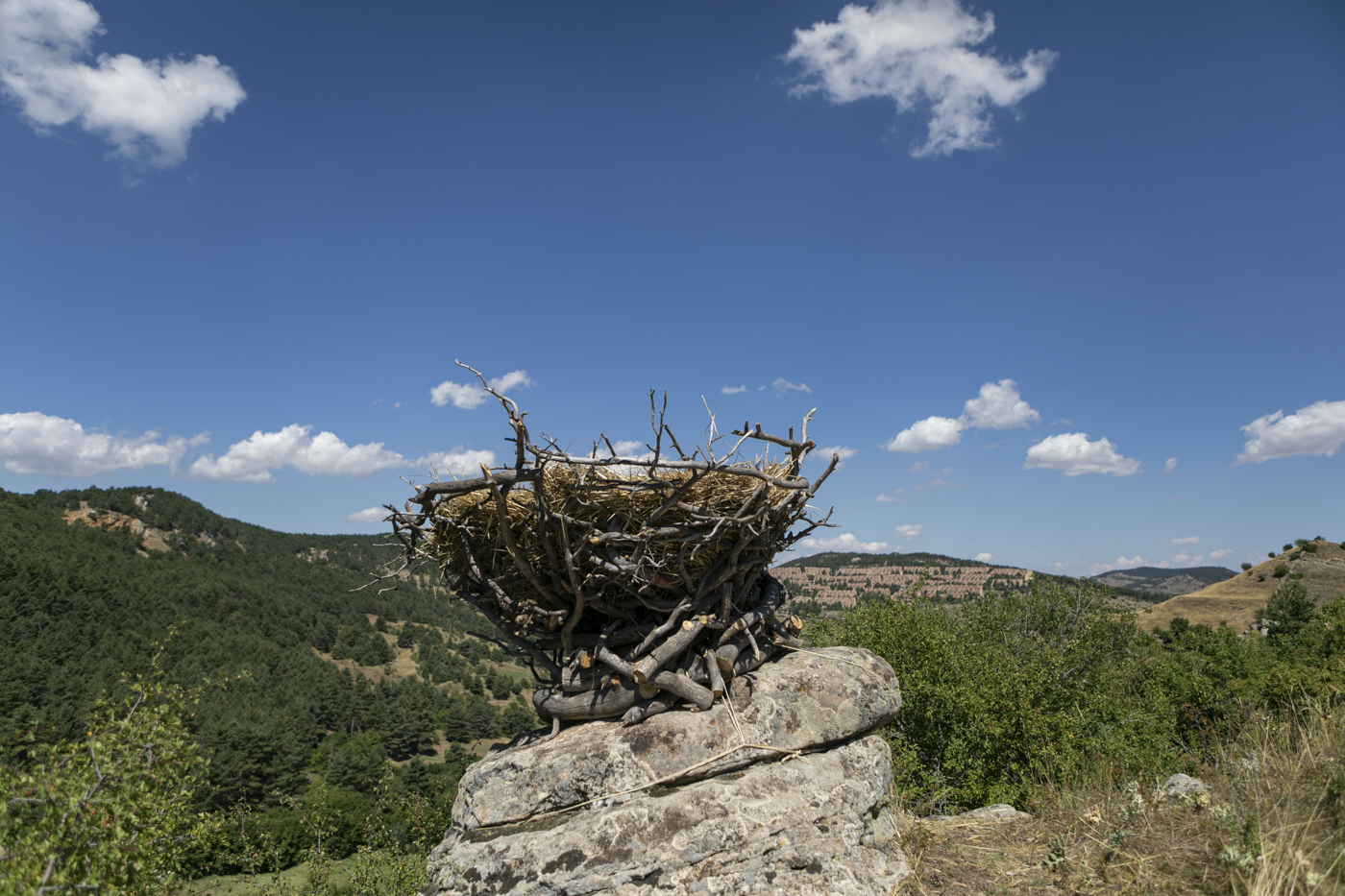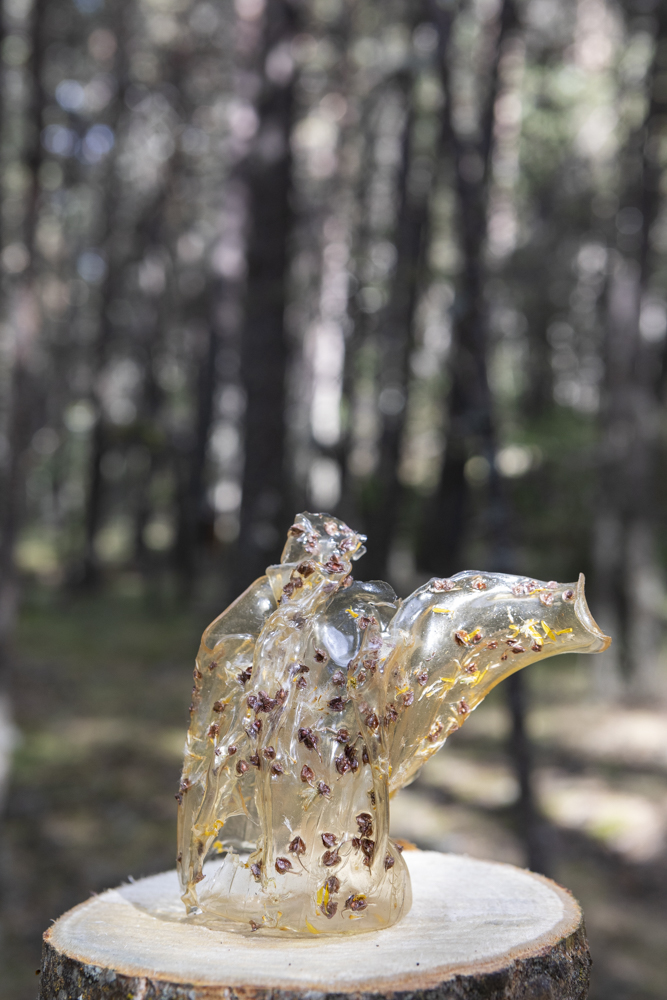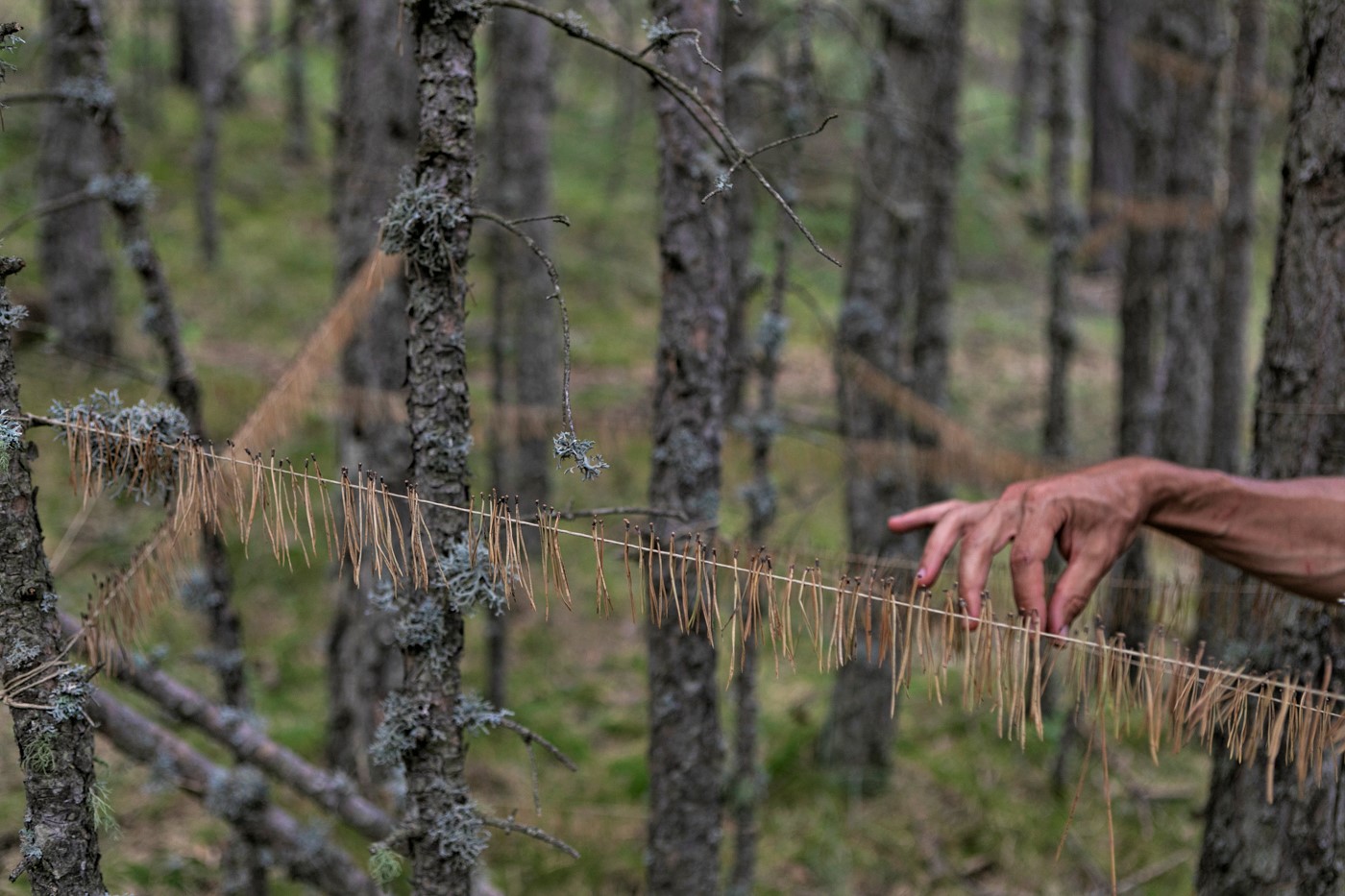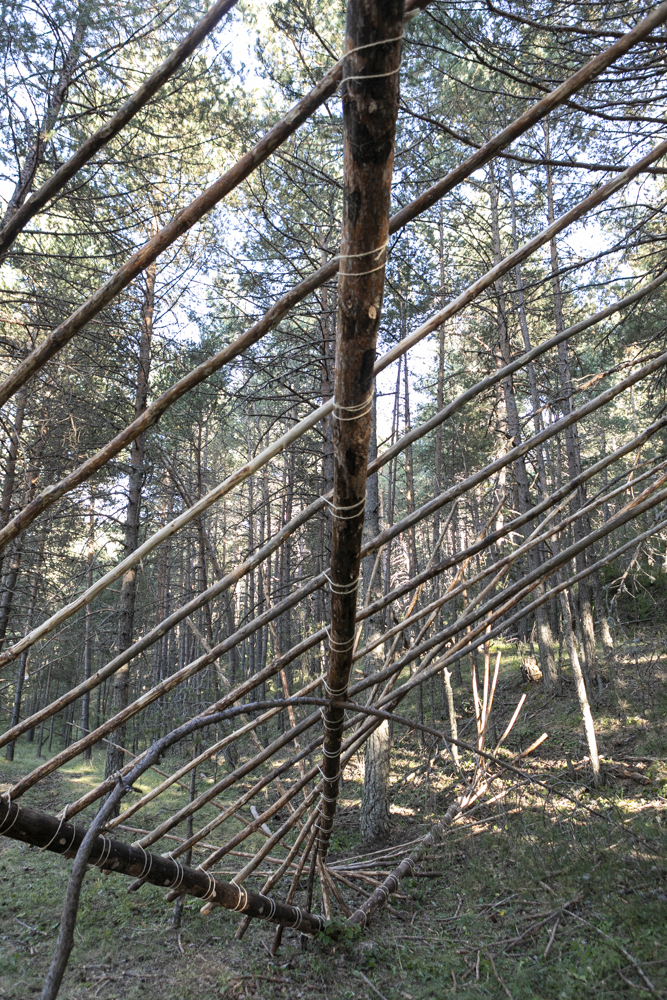Landares Festival is a one-week gathering of people working to explore the potential of land art as a means to investigate new forms of sustainable relationships between human beings and nature. It takes place in a rural area, where participants, visitors and local population are invited to create artistic installations and performances with natural on-site materials, zero waste and locally inspired contents.
Festival Landares has been taking place every summer since 2016 (except 2018) for one week at Alcalá de la Selva (Teruel, Aragón). In this application, we’ll only refer to examples from the 2020 and 2021 editions, both of which fall into the time frame established in the guidelines.
During the last week of July Asociación Landares promotes a program of activities in and around the village under a non compulsory leitmotif (2020 Cycles, 2021 Memory). We are supported by the municipality and openly invite residents and visitors to join any of them. The eve of the opening, in a frequented venue near the village, we build a physical natural structure, as the basis for a collaborative performance on the first day of the Festival, a Sunday. We invite passers-by to build their own creations on these structures, while informing them about sustainable land art and inviting them to the rest of activities.
The core offering of the Festival is the building of land art installations in a selected area of the surrounding forest from Monday to Friday. They are carried out by a group of invited participants from very different backgrounds and geographical origins. After an informative talk about the site, they are free to explore it in search of inspiration, and decide where and with which materials, tools or methods to work, how many pieces and installations to produce and if they do so individually or in groups. As long as the environment is highly respected and the works, which will later remain there, can naturally degrade, everything is allowed.
On the following Saturday, every artist shows and explains her/his work in a tour for the public. Before dawn, a special atmosphere is added to the final part of the tour by a sound and music performance by the group Sonorabisal.
The 2021 edition saw two firsts: the inclusion of performing arts (a collaborative choreography, a theater piece and a video improvisation) and the invitation to an internationally renowned land artist
Please highlight how the project can be exemplary in this context
Our basic philosophy is utter respect for nature. We aim to bring this ideal down to earth and give people the opportunity to find their own meaning for themselves. From this conviction, we invite artists and visitors alike to turn this new understanding and respect into actions. The basic lines we propose include:
No artificial materials and maximum reduction of waste. The vast majority of materials we work with should be taken from the very site we’ll work upon. No live matter, only fragments already shed off by biological processes. As installations will remain on the site, we ensure its components can decompose in a natural way.
An exception are discarded objects already present at the site, when they exhibit a certain historic or symbolic value. One of the artists has thus used old, rusty food cans from the Civil War as the center feature of his work, considering them as part of the landscape history.
Reuse. Occasionally we include objects we recover from the village dump site and then take with us the last day, if they cannot be naturally decomposed. Thus, we temporarily remove their waste status and make visitors reflect upon the very concept of waste and revalue, especially if they have themselves discarded these objects in the first place. Along this line two of our artists have even “reused” in 2021 their own works from 2020, building upon them with a different approach and so reframing their message. And the poplar branches of the Forest of Memories in 2021 opening participative installation were later on reused as scenographic elements for the choreographic performance at the chapel cloisters.
Sustainability permeates the whole festival. We use wooden hand-made signs to mark the venues and works, wear customized organic and naturally dyed T-shirts, use public or shared transport to and within the working areas, promote respectful tourism and visit nearby villages and and nature, especially highlighting sustainable traditions and initiatives.
Please highlight how the project can be exemplary in this context
As an art festival, aesthetics are by definition inherent to our project. And as a land art initiative we present nature as a source of inspiration. We chose Alcalá de la Selva for the rich possibilities of its changing landscape of meadows, forests, rocky cliffs and mountain ranges.
On a less obvious level, we encourage participants to look for a sense of beauty in the working process itself: the search for the place, the material, the forms, the messages we expect to convey. Once the aesthetic look sets on, we discover new applications for natural elements, and find genuine pleasure and beauty in this new connection to forest, rocks or meadows as creative materials or tools. Our approach to work demands a closer, renewed look at colors, shapes, textures, odors, a deeper understanding of interactions in biological and geological phenomena, and requires the opening of a personal inner space to let all these elements sink in and elicit new sensations, feelings and thoughts. Together they set up an emotional and intellectual call to artistic actions and to the positive effort to express our messages in a form that can personally resonate in others.
Some of the works are designed not to transform, but lay bare the awe we usually miss in nature: the “cleaning” of fallen tree roots, the reading out of scientific research about plant unknown “abilities” from the middle of a group of growing trees. This applies also to the interventions in the village venues for participative activities and performances: both year opening days highlight the vegetal elements in humanized spaces harmonically fusing with them. The selection of the chapel cloisters and the natural forest stage for the performing and musical arts activities aimed as well to endorse an innovative aesthetic approach to existing places.
The Festival itself has evolved to enrich the aesthetic experience with the addition of new artistic disciplines called to collaborate with the already present ones.
Please highlight how the project can be exemplary in this context
As an art festival, aesthetics are by definition inherent to our project. And as a land art initiative we present nature as a source of inspiration. We chose Alcalá de la Selva for the rich possibilities of its changing landscape of meadows, forests, rocky cliffs and mountain ranges.
On a less obvious level, we encourage participants to look for a sense of beauty in the working process itself: the search for the place, the material, the forms, the messages we expect to convey. Once the aesthetic look sets on, we discover new applications for natural elements, and find genuine pleasure and beauty in this new connection to forest, rocks or meadows as creative materials or tools. Our approach to work demands a closer, renewed look at colors, shapes, textures, odors, a deeper understanding of interactions in biological and geological phenomena, and requires the opening of a personal inner space to let all these elements sink in and elicit new sensations, feelings and thoughts. Together they set up an emotional and intellectual call to artistic actions and to the positive effort to express our messages in a form that can personally resonate in others.
Some of the works are designed not to transform, but lay bare the awe we usually miss in nature: the “cleaning” of fallen tree roots, the reading out of scientific research about plant unknown “abilities” from the middle of a group of growing trees. This applies also to the interventions in the village venues for participative activities and performances: both year opening days highlight the vegetal elements in humanized spaces harmonically fusing with them. The selection of the chapel cloisters and the natural forest stage for the performing and musical arts activities aimed as well to endorse an innovative aesthetic approach to existing places.
The Festival itself has evolved to enrich the aesthetic experience with the addition of new artistic disciplines called to collaborate with the already present ones.
Please highlight how this approach can be exemplary
All our actions are ecological, show an aesthetical dimension and tend to bring a population as wide and inclusive as possible closer to nature and ecology. That's how we try to combine all three aspects throughout the Festival:
The opening participative installations inspired to bond with nature, even in an unusual place for it, through artistic activity with no specific technical requirements. They were sustainable, inclusive – everyone was invited to co-design and build them–, informative about land art and very encouraging for the exchange of experiences, knowledge and thoughts.
2020. At a meadow park by the local chapel. Hemp cords hanging from a geometrical array of thin tree trunks presented as a scaffolding for land art pieces made by festival artists and villagers and tourists passing by working together.
2021. At a poplar grove promenade in the village. “Forest of Memories” supposedly grown out of the asphalt, built with poplar branches (pruning remains). People were invited to further design the forest with natural materials, and share their memories of the venue and village on pieces of paper they attached as “leaves” to the branches.
Works in the forest. The invited artists (10 in 2020, 18 in 2021) had to learn (intellectually, technically and emotionally) about nature and the local environment in order to find their subject and execute their work in a difficult and enriching balance between aesthetics and ecological handling.
Performing arts. Contemporary dancer and choreographer Miquel Barcelona carried out a thorough research among villagers and academics in the area about two subjects: a traditional dance and peculiarities of the Civil War in the region. With this information and the recorded texts and music (cultural heritage) he choreographed a piece performed by land artists and villagers. The theater improvisation during the tour forest by another artist was also inspired by this research. Both used natural "props".
This year the number of participant artists has increased, including the number of children, as well as the public and citizens involved in our activities. This means a wider impact of our message and philosophy and a broader source of experience to find new ways and levels of interaction with nature. The Festival has also found a bigger echo in the media than in previous editions.
This consolidation has led international land artist Jean Paul Ganem to accept our invitation to collaborate with us. Although we initially only asked him to develop one of his creations as part of the festival for 2022 / 2023 (depending on covid evolution and plant growth requirements), he has announced a wider implication by also attending 2022 edition as a sort of “tutor” for other participants, while he continues working in his own project for the region. His presence and talk at the Town Hall in June 2021 helped foster awareness of the importance of land art for the ecology and the sustainable development of rural environments.
During our planning and research for the different activities of the festival, we have also widened our network of contacts and possible collaborators, including professionals as advisors (in botanical sciences, land and forest use and care, nature protection figures) and contributors to our activities. Our approach to connect with nature becomes so nurtured by informed and solid sources and, at the same time, finds a way to take part in the sustainable development of the area. The increasing involvement of the local authorities and the wider knowledge and acceptance of the Festival in a region not very used to cultural innovation in the last decades show that we have found a common ground with them: respect for nature. A symbolic evidence of this is that every year, in the weeks after the Festival, we find spontaneous interventions at the site of our work carried out by anonymous visitors.
Please also explain the benefits that derived from their involvement.
The initiative for Landares Festival came from a group of friends interested in land art. They started the first gathering as an experiment, later refined by the interaction with new artists and the local community. In 2019 some of them founded the non-profit Asociación Landares, to officially promote the Festival.
There are different sorts of citizen implication:
- artists from urban environments embed themselves in nature and try to understand its underlying processes before enriching it through their own expertise, knowledge and ideas. Many of them, new to the area, experienced first hand the reality of the so-called España vaciada (devoid Spain, rural areas with ever less population and endangered economic development) and became compelled to contribute to their dynamization.
- artists from the village or nearby act as a bridge by bringing in local knowledge, culture and connections and spreading the results of interactions during the Festival to their everyday environment.
- informative talks about the geological, botanical, cultural and historical characteristics of the site are given by some specially committed villagers
- in 2021, the research work for the choreographic performance required collaboration from numerous citizens: in-depth interviews to two academics, one specialized in traditional dance and another one in Civil War in the area, five adult and a group of children villagers who told about the traditional dance, showed it and sang traditional songs to be recorded, and a visitor who shared memories of his childhood holidays at the village.
- villagers also collaborated in the gathering of material, facilitation of tools, information and even granting permission to carry out one of the works in a privately owned field.
- all sorts of citizens shared their joy about the festival contributing to a positive and nurturing atmosphere.
- Lack of awareness about climate emergency.
Direct contact with nature and the rural population makes the effects of this phenomenon evident and undeniable. We can observe shifts in altitude levels of vegetation, hear about lack of precipitation and the economical consequences for a village with a ski resort as one of its main income sources, and are confronted with the everyday struggles of the rural population once living out of farming for wool, which became much cheaper if imported...
- New business models.
Although still small and in need of funding, our Festival would like to show how sustainable, nature friendly offers can attract a new form of tourism, as more and more people become aware (an awareness we also hope to nurture) of the need of living in balance with nature.
- Exhaustion of raw materials and carbon footprint of production and transport for them
Our activities draw upon regarding materials from a new perspective, finding them in unexpected places, combining them in new forms. Learning about traditional uses and recovering them when possible (some artists worked with pine resin biomaterials in 2021). As explained above, we reuse and recycle materials and works, some of the artists work on developing new biomaterials outside the Festival, but tell about it during it, spreading the word, expanding the conscience of a new way of producing, of consuming. Talking about circular economy and saving resources.
If we compare to other leisure activities in nature, we don't just contemplate it, but really interact with it in an intense and respectful way, which involves a certain conversation with the environment. We need to learn about it, acknowledge it and stick to its rules before and during our "giving back" to it.
As for other land art events, they are really scarce in Spain and non existent, to our knowledge, in the region where we are active. As for what we know about other Festivals everywhere, Landares innovations would be:
- land art is not always ecological, the broad definition is "art in nature" and sometimes includes works made out of plastic or other artificial materials. In this sense, we have imposed on ourselves a very strict sustainable ethic, where we pay attention to reducing impact, carbon footprint and waste wherever possible.
- we are open to every kind of people, as explained, with no registration fees or selection process for artists and express invitation to everyone to come, observe and collaborate at every stage of the process.
- as opposed to other festivals, where artists must submit a project beforehand and sometimes even arrive at the venue with parts (or the whole) of it already build, we encourage people to come as free-minded as possible. We consider important to commit to the very place we are going to work in, to listen to it, learn about it and get inspiration from this very concrete and local interaction. As part of these approach, we ask the artists to work with on-site materials.
- we place high value on the interaction with local population. We consider human interactions essential for any bottom up solutions for ecological problems, which we pursue as part of our project.
- we consider the combination and balance of these three levels of sustainability (economical, social, environmental) another distinctive feature of Landares. And therefore try to spread it as widely as we can.
Please provide clear documentation, communication of methodology and principles in this context.
We consider the practices and experiences gathered in these years transferrable to other parties and contexts. One of them being the necessity to adapt all activities to the very specific place and environment you'd like to work in. And therefore, step number one should be to know it as well as possible.
In rural environments, the natural milieu for a land art festival, this process should happen on a personal contact basis. Although it is possible to first reach out through social media to key players, associations and active private people from the region, in person meetings will soon appear as a must.
Taking our philosophy into account, it has worked very well for us to look for artists from our personal circles at first and expand them organically to the circles of newcomers. As said, with no other criteria than the commitment to respect our philosophy and a genuine interest in exploring land art.
As for the work itself, also as mentioned before, the basis is to get to the place, explore, respect, get information and work. But the more detailed suggestions vary depending on the characteristics of each site. It is important to foster a good atmosphere among participants, highlighting the advantages of working together and sharing knowledge and experience with each other. In this regard, we facilitate the coming together at meals and leisure time and provide opportunities to bond among them and also with villagers and visitors.
We also seek connections to local associations and agents, as well as researchers working ion our subjects of interest within the area.
As for funding purposes, we started addressing the local authorities, applied to provincial and regional subsidies later on and are presently in the process of looking for private funding.
A selection of media appearances:
2020 Edition:
https://www.diariodeteruel.es/movil/noticia.asp?notid=1026560&secid=6
https://www.youtube.com/watch?v=n67oedA4JuA
2021 Edition:





@Asociación Landares, 2021
Content licensed to the European Union.